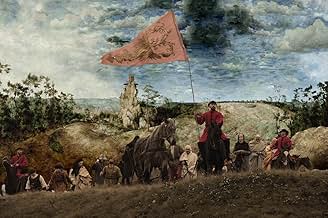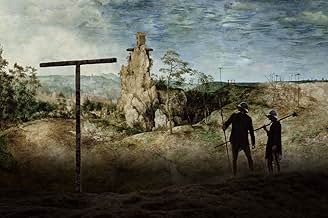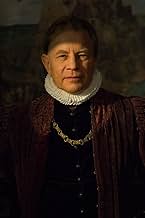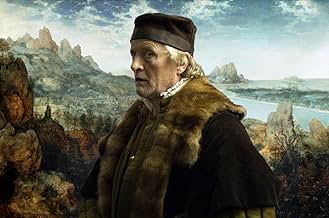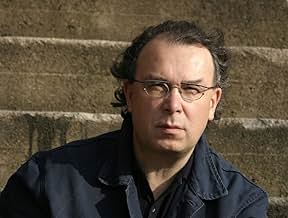VALUTAZIONE IMDb
6,9/10
4491
LA TUA VALUTAZIONE
Aggiungi una trama nella tua linguaThis movie focuses on a dozen of the five hundred characters depicted in Bruegel's painting. The theme of Christ's suffering is set against religious persecution in Flanders in 1564.This movie focuses on a dozen of the five hundred characters depicted in Bruegel's painting. The theme of Christ's suffering is set against religious persecution in Flanders in 1564.This movie focuses on a dozen of the five hundred characters depicted in Bruegel's painting. The theme of Christ's suffering is set against religious persecution in Flanders in 1564.
- Premi
- 10 vittorie e 7 candidature totali
Trama
Lo sapevi?
- BlooperA few minutes before the end of the movie, a red automobile crosses the background between two houses, while Bruegel and Nicholas Jonghelinck are speaking in the foreground.
- Colonne sonoreMiserere, Opus 44
By Henryk Mikolaj Górecki
Performed by the Silesia Philharmonic Choir (Chorus Master Jan Wojtacha)
Recensione in evidenza
The Mill and the Cross (2011)
The Polish film "The Mill and the Cross" was co-written and directed by Lech Majewski It stars Rutger Hauer as Pieter Bruegel, and co-stars Charlotte Rampling and Michael York.
The film consists of an attempt to bring to life Bruegel's 1564 painting, "The Procession to Calvary." I have seen this painting in the Kunsthistoriche Museum in Vienna. Once you've seen it, you don't forget it, because it is filled with people and action. (Although, in the painting, Jesus has just collapsed under the weight of the cross, so, in a sense, action has been frozen for a few seconds.)
The painting is also remarkable for a very strange symbol--a windmill placed high atop a stony crag. In the film, Bruegel explains that the miller looks down from his mill and sees everything that is happening below, just as God looks down from heaven and can see everything. So, the mill and the miller work symbolically. However, in a practical sense, the mill would never be that high on an large, steep, stony crag. If a mill were really in that location, no one could bring the wheat to the mill or take away the flour.
The other dominant vertical structure is a cartwheel, raised high on a long pole. This was the device used by the Spanish rulers of the Netherlands to execute and display prisoners. The prisoner was tied to the wheel, and the wheel was hoisted far up in the air. The device prevented anyone from helping the person--if alive--or removing the body. Only the carrion birds could reach the body, which they did, with predictable results.
Technology in the 21st Century makes everything possible, so it's no surprise that the painting is reproduced in the film in a real landscape. Sometimes all the figures are frozen, but other times you can see a cow moving or some other action taking place. The special effects are routine by now, but the manner in which they are used is not routine.
We really have the sense that we are looking at a landscape, and the artist is putting it down on canvas before our eyes. This is a highly creative way to look at life the way an artist sees it, and then look at the way life is transformed and committed to canvas.
We saw this film on the large screen at the excellent Rochester Polish Film Festival. It really will work better in a theater. However, if that's not an option, it's worth seeing on DVD.
The Polish film "The Mill and the Cross" was co-written and directed by Lech Majewski It stars Rutger Hauer as Pieter Bruegel, and co-stars Charlotte Rampling and Michael York.
The film consists of an attempt to bring to life Bruegel's 1564 painting, "The Procession to Calvary." I have seen this painting in the Kunsthistoriche Museum in Vienna. Once you've seen it, you don't forget it, because it is filled with people and action. (Although, in the painting, Jesus has just collapsed under the weight of the cross, so, in a sense, action has been frozen for a few seconds.)
The painting is also remarkable for a very strange symbol--a windmill placed high atop a stony crag. In the film, Bruegel explains that the miller looks down from his mill and sees everything that is happening below, just as God looks down from heaven and can see everything. So, the mill and the miller work symbolically. However, in a practical sense, the mill would never be that high on an large, steep, stony crag. If a mill were really in that location, no one could bring the wheat to the mill or take away the flour.
The other dominant vertical structure is a cartwheel, raised high on a long pole. This was the device used by the Spanish rulers of the Netherlands to execute and display prisoners. The prisoner was tied to the wheel, and the wheel was hoisted far up in the air. The device prevented anyone from helping the person--if alive--or removing the body. Only the carrion birds could reach the body, which they did, with predictable results.
Technology in the 21st Century makes everything possible, so it's no surprise that the painting is reproduced in the film in a real landscape. Sometimes all the figures are frozen, but other times you can see a cow moving or some other action taking place. The special effects are routine by now, but the manner in which they are used is not routine.
We really have the sense that we are looking at a landscape, and the artist is putting it down on canvas before our eyes. This is a highly creative way to look at life the way an artist sees it, and then look at the way life is transformed and committed to canvas.
We saw this film on the large screen at the excellent Rochester Polish Film Festival. It really will work better in a theater. However, if that's not an option, it's worth seeing on DVD.
I più visti
Accedi per valutare e creare un elenco di titoli salvati per ottenere consigli personalizzati
- How long is The Mill and the Cross?Powered by Alexa
Dettagli
- Data di uscita
- Paesi di origine
- Sito ufficiale
- Lingue
- Celebre anche come
- The Mill and the Cross
- Luoghi delle riprese
- Wieliczka, Malopolskie, Polonia(mill interiors)
- Aziende produttrici
- Vedi altri crediti dell’azienda su IMDbPro
Botteghino
- Lordo Stati Uniti e Canada
- 312.187 USD
- Fine settimana di apertura Stati Uniti e Canada
- 11.354 USD
- 18 set 2011
- Lordo in tutto il mondo
- 1.116.180 USD
- Tempo di esecuzione1 ora 32 minuti
- Colore
- Mix di suoni
- Proporzioni
- 1.85 : 1
Contribuisci a questa pagina
Suggerisci una modifica o aggiungi i contenuti mancanti

Divario superiore
By what name was I colori della passione - The mill and the cross (2011) officially released in Canada in English?
Rispondi

